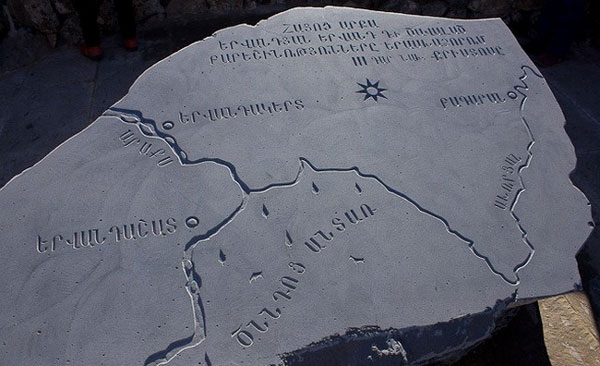By Gourgen James Khazhakian
The last capital of the Kingdom of Yervanduni (Orontides) Royal Family was situated in Yeraskhadzor region of the historical province of Ayrarat on the left bank of the Arax River. It was founded in 210 B.C. by the Armenian King Yervand (Orontes) IV. Chronologically, Yervandashat is the third capital of Armenia. Today, traces of walls and various buildings such as economy rooms, of the ruins of two medieval churches, cross-stones, lithographic inscriptions have been preserved near the same name village of Armavir Marz (Province) of the Republic of Armenia.
According to Armenian historian Movses Kaghankatvatsi , the city was founded as a new capital of Armenia in order to replace Armavir which had been abandoned by its population due to a water shortage caused by a change in the direction of the flow of the Arax River.The new capital city had a solid position and was more abounding in water.
The citadel was built on the rocky hill and had thick walls constructed with huge quartzes which were connected to each other with iron nails. It also had other defensive structures, special water supply system and a number of dwellings. Copper doors and iron stairs were installed in the walls and the hidden traps were placed into them.
On the opposite, the left bank of Arax (territory of Turkey by now) which was once connected to the City by a stone bridge, a strong fortress called Yervandakert was built, the remains of which have survived to these days as well. It was unique of its impregnability and its beautiful setup.
Yervandashat remained the capital of Armenia until the transfer of the royal residence to the city of Artashat in 160 B.C.
At the beginning of the 4th century A.D., the King of Greater Armenia Trdat III transferred the city, which by that time had become the center of the Arsharunik region, to the Kamsarakan family.
Until the middle of the IVthcentury A.D. Yervandashat was one of the largest cities of Ancient Armenia having some fifty thousand residents, developed trade and culture.
According to another Armenian historian Pavstos Buzand , Persian invasions of the IV century A.D. were fatal for Yervandashat. In 364invaders of Persian King Shapuh destroyed the city, and the biggest part of the population was taken prisoners to Persia and once prosperous city became a feudal fortress.
From the surviving gravestone inscriptions, it is clear that Yervandakert, in turn, was inhabited in as far back as the 15th century and was called Marmeta.
Alas, in contrast to Yervandashat, nothing or almost nothing is known about the current state of Yervandakert as it is at Turkish side, and every time when Armenian or even non-Armenian archaeologists appeal to the Turkish power for excavations permission, they dictate conditions like construction of highway, hotel, etc, etc…














